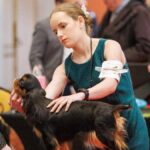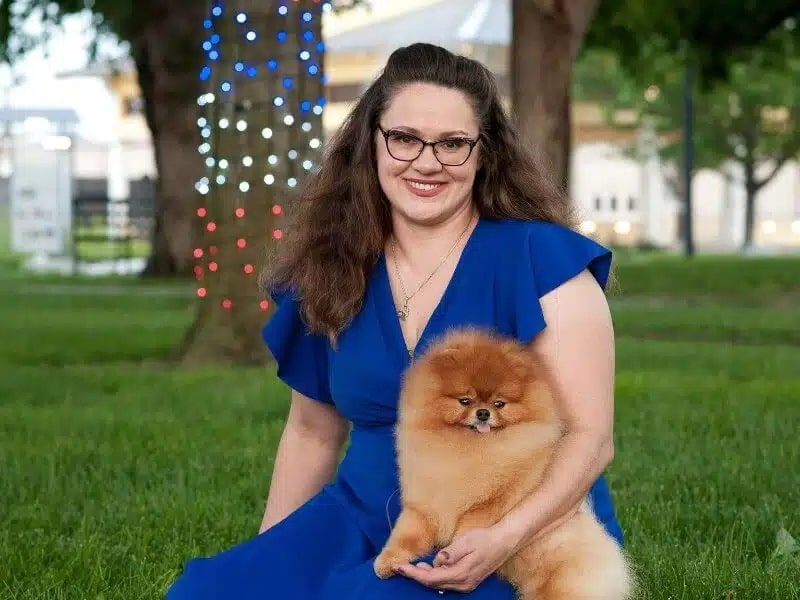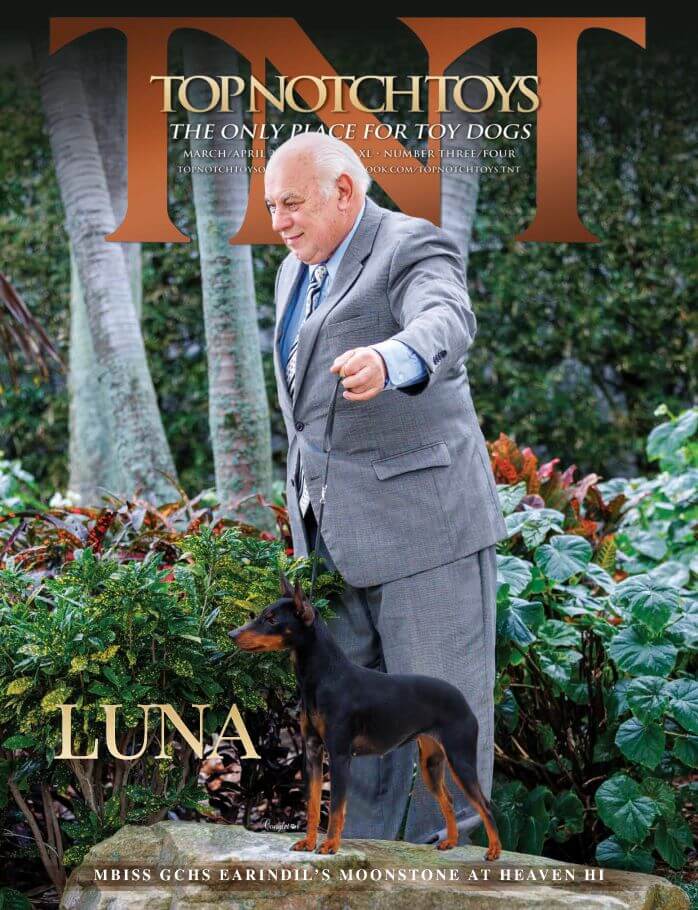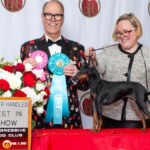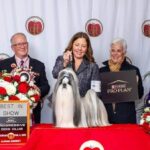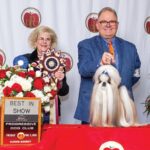Interview with Aly Bell, Breeder of BallOFur Pomeranians & InfiniteStars Japanese Chin
Where do I live? How many years in dogs? How many years as a breeder?
Aly Bell: I live in Texas just south of the Dallas/Fort Worth Metroplex. I started showing 16 years ago. I have been breeding Pomeranians for 13 years and Japanese Chin for 10.
What is my kennel name? How many dogs do I currently keep?
Aly Bell: I breed Pomeranians under the BallOFur prefix, and Japanese Chin under the InfiniteStars prefix. I started my Chin program with Infiniti, but began a breeding partnership with Adrienne Wolfson of AzureStar kennels and cattery. We combined our kennel names for the Chin to form InfiniteStars. I personally keep a small number of dogs in my programs, as I am a professional handler and I’m on the road often. I usually have 4-6 of each breed at any given time, depending on how many puppies I am growing up.
Which show dogs from the past have been my noteworthy winners?
Aly Bell: My first Group-winning Pomeranian was GCHB Expression I Got You Under My Skin GC, HOF, “Sinatra,” sired by my first home-bred Champion, GCH BallOFur’s Bye Bye Birdie At Cin Dur, “Hugo.” Shown by Curtiss Smith, he won multiple Toy Groups and was a Top 10 Pomeranian.
GCHG BallOFur’s Maybe I’m Amazed, “Paul,” was the Best of Breed winner at the 2022 AKC National Championship in Orlando, has been a Top 10 Pomeranian twice, and is also a multiple Group and Reserve Best in Show winner.
In Japanese Chin, Adrienne and I bred the current Number One (All-Breed) Japanese Chin for 2023, GCHB Touche & InfinitiStars The Puppet Master, “Mr. Perfect.” He was bred and raised here, finished to his GCH as a puppy by myself, went to Dale Martenson to grow up a bit, and was shown to his first Group First by Dale.
He went on to some success with Andrew Peel on the East Coast in 2022, and is currently being shown by Luke and Rowan Baggenstos, owned currently by Pamelia Hill and Jane Martenson. He is the product of two Touché dogs, thus the nod to Touché in his registered name, as without Dale and Jane’s decades of commitment to the breed he would not be here. He is the first and only Tri Color Japanese Chin to have not only one Best in Show but multiple, as well as a RBIS. He has accomplished so much with Luke and Rowan in a short time. We feel the sky is the limit for him.
Which have been my most influential sires and dams?
Aly Bell: BISS GCHS Silhouette’s Seeking Nirvana, “Cobain,” came to me to be shown to his Grand Champion title and earn a spot in the Top 20 for his owner, Deb Snow. I was able to use him while he was here and he produced two beautiful litters, the first of which yielded me three Grand Champions (one reaching Silver and one reaching Gold).
Known as the “Beatles” litter, “Paul” and his brother “Johnny,” BISS GCHS BallOfur’s Happiness Is A Warm Pom, both went on to be multiple Group winners, Specialty winners and, in 2021, both boys were in the Top 10, shown only by me, for six months of the year each. “Harrison,” GCH BallOFur’s Snuggle Bear Sheehan, was also shown by me but lives his life more as a pet for his family. He did, however, obtain multiple Group placements in a short time as well.
The Beatles boys’ mother, “Alice,” Johnnylicious Down The Rabbit Hole, ROM, was the “restart” to my program. A daughter of GCH Silhouette’s Stark in Winterfell, “Bran,” she not only produced the Beatles boys but two more Champion females by two different sires, with one more on her way to finishing which will give her an ROMX in four total litters with only a few being kept back to show. I look forward to seeing what her daughters will produce for me going forward.
Our Japanese Chin “Ava,” CH Touche’s Who Do You Love At Skoshi, and her daughter, “Lily,” InfiniteStars The Lady Is A Vamp, have both proven themselves over and over in the whelping box. Ava has produced four champions for us, including Mr. Perfect, with a few more left to finish, and Lily has produced three Champions, with one currently lacking a single point and more to come from her in the future. We have been so blessed with great free-whelping dams who love taking care of babies.
Can I talk a bit about my facilities? Where are my puppies whelped? How are they raised?
Aly Bell: Puppies are whelped in the bedroom, most of them in the bed, and raised in a drop pen close to the bed. This makes it much easier to keep a close eye on moms about to deliver as well as supervising newborns. Once they are toddling around, they are moved to a playpen on the floor and started on a licker bottle and puppy kibble when they show interest in food. They are provided plenty of toys for stimulation. After vaccinated, they are moved to the living room where they start to learn the housedog routine and get to run this house.
At around 5-6 months, provided they are eating well and show no signs of hypoglycemia issues, they will move to our kennel, which is a double-insulated and climate-controlled building. The kennel building is temperature-monitored as well, with multiple AC units and temperature sensors. Keeping the babies in the house and close to us early on is so crucial for keeping an eye on these little guys, as raising Toy Dogs can be so challenging. They are prone to so many issues and you don’t get many at a time, so making sure the ones that do live are given the best chance is very important to us. These are not breeds that you can usually leave to their own devices and interact with twice a day.
What is my “process” for selecting Show Puppies? Performance Puppies?
Aly Bell: At around 8-12 weeks, once puppies have had at least two shots and have moved into the house, we start watching them as they interact with the older dogs and move around. We can get a good idea of their attitude and movement, and see if they have the drive to be a show dog. This is when we start analyzing them and make our cuts for show vs. pet homes. I don’t breed for Performance Sports, but as I do get some inquiries I try to be mindful of the dogs that seem to have the drive to learn like it’s their job.
When choosing a show prospect, I am looking for the overall shape, the attention to stimuli (treats or toys), and if they move appropriately and carry themselves confidently through the house. The dogs which seem timid and insecure are either given extra attention or placed as pets, as outgoing temperament is very important to us.
How important are Breed Specialties to me? How important are Group Shows?
Aly Bell: Being able to win any Specialty is an honor, especially when it’s a Breed Specialty.
What are my priorities when it comes to breeding? What are the drawbacks?
Aly Bell: Priority for me is breed type and health, hopefully resulting in longevity. In Pomeranians, I want a square dog with proper head carriage for the breed, balanced movement, a high tailset, and good coat.
In Japanese Chin, we look for square to off-square in our puppies, a single coat, cushion to the cheeks with a strong underjaw, and most importantly, the nose in the face. Without the nose in the face, you will not have the correct “reverse 3” to the profile of the head. And as Chin can be aloof with strangers, we do try to keep the more outgoing personalities so that they are not too scared to actually be show dogs or meet strangers. Even when selling pets, it is very difficult to place shy or skittish dogs in most homes.
Drawbacks to raising Toy Breeds are, of course, fragility and being prone to hypoglycemia as babies. The ones that tend to go very badly hypo can be more prone to it even as adults. And again, temperament, as no one wants a shy, yappy, or nippy Toy Dog for a pet.
How would I define “conditioning” as it relates to my breeds? How important is coat care?
Aly Bell: Conditioning is very important for any breed. For the Pomeranians, we need to stay on top of the coat changes and sheds throughout their life. They cannot put in new coat till the old coat has shed out, so bathing every 4-6 weeks at a minimum, to prevent undercoat from packing, is important. Also, keeping their skin healthy so that they can grow a healthy coat, and not trimming too short, allows for healthy growth.
In the Japanese Chin, we remember that clean hair grows, so weekly bathing and combing out of tangle-prone areas, like behind the ears, is important. We sometimes oil ear fringes or wrap tails and skirts, as they get long enough to drag the ground, to prevent breakage.
Are there any health-related concerns in my breeds? Any special nutritional needs?
Aly Bell: As with most Toy Dogs, patellas are something we struggle with in both breeds. As it is a polygenetic trait, you can get good knees from parents with bad knees and vice versa, so OFA testing is a great tool to be aware of what is behind each dog.
Hearts seem to be more of an issue in the Chin, and can go from no issue to serious very quickly. So, staying on top of those cardiac tests and starting on appropriate medication at the first sign of a murmur will help to limit serious problems, but limiting the use of any offspring of a dog which develops serious cardiac issues early on is the best way to ensure longevity. Again, it boils down to making sure the necessary health tests are being done or at least those things are being checked often by your vet, and being aware of patterns, lines, and tracking the development into late maturity to make decisions for the future.
We cannot always wait till a dog is eight years old (or even four as is required for Chin OFA cardiac testing), but we can be aware of what dogs do as they mature and make decisions for their offspring once we are aware of issues.
Pomeranians tend to require more fish oil or any good fat source to keep their coat healthy, as they are prone to alopecia and other coat issues. While some forms of coat loss are genetic and untreatable, there are a variety of dietary deficiencies that can contribute to it as well, so feeding a good diet, preferably fish-based, seems to be the best for them.
Do I think my breeds are supported by a sufficient number of preservation breeders?
Aly Bell: No. It is much worse in the Japanese Chin, but I am happy to see that we are no longer a low registration breed in the US as we once were. But even in the Pomeranians, as popular as they are for breeders and pet buyers, the number of preservation breeders is dwindling and we are being overrun with a new generation of breeders who don’t truly understand either the Standard or why we show.
Finding a quality mentor is hard enough as it is, but when people try to mentor and are not listened to it makes it hard to truly mentor anyone when our teaching goes unheard. There are only a handful of show breeders in Chin in the entire country, many of whom do not work together, and the strict contracts and limiting of sales on full AKC registration has hurt the breed in recent years.
As the numbers start to shrink across the country, I believe ALL breeders need to take a serious look at any restrictions they are placing on their stud dogs and puppies sold. I do not endorse strictly breeding to sell pets or letting dogs get into the hands of puppy producers who may cross-breed, but I do think the practice of “I don’t like this person so they can’t have anything out of my dog” needs to be addressed or we will end up with fewer and fewer breeders who can actually work together.
The days of large kennels that could sustain themselves are over, as AR-driven laws are being passed all over the country. We need to be able to work together for the good of the breed if we want to continue to preserve the breeds we love.
Are my breeds well suited to be a family dog? Who are the best candidates to own my breeds?
Aly Bell: Japanese Chin are WONDERFUL family dogs. They are little clowns who love to entertain and play and snuggle their people. The Pomeranian is also a great dog, but they do require a little more socialization and training so that they don’t get too protective or yappy. They will snap at a small child who doesn’t respect their space, so I tend to screen homes with small children extra hard so that the parents understand not to treat the Pomeranian like a stuffed animal.
They are both also very fragile, so being mindful of jumps and falls which could result in a broken leg, back, or head injury, etc., is also something to keep in mind. They are small and smart and can squeeze through small spaces, so if you live on the upper floor of an apartment and have a balcony with open gaps, making sure to close those is crucial to avoid tragedy.
The best candidates for these breeds are people who will respect their small size, personal space, and safety. I do not endorse letting any dog run loose in public, but especially a small dog which could be easily killed by a car or picked up by a hawk. Someone devoted to training to ensure obedience and housebreaking is also a good candidate for a Toy Dog.
What are the biggest misconceptions about my breeds? What are my breeds’ best-kept secrets?
Aly Bell: The biggest misconception of the Japanese Chin: just because the breed calls for aloof with strangers doesn’t mean they are skittish or have no personality. THEY are the best-kept secret in the Toy Group, in my opinion, as they make the best pets. They are relatively healthy, low maintenance, and the perfect balance of energetic and “chill.” They love their people but are independent enough to entertain themselves if left alone, unlike many Toy Breeds which can be very needy.
Pomeranians have a bad reputation for being too barky for most people. And while this is true of many Pomeranians, I would like to say that it is very genetic and heavily dependent on socialization and exposure. If you let your Pomeranian be a yappy little ankle biter, that is what it will be. If you are FIRM with the dog and don’t allow the behavior from an early age, it will enforce that that is NOT allowed. And also, some lines or certain dogs do tend to be more laid-back and quiet than others. So, while the breed can be that way, a lot of it is a lack of training.
If I could share a comment or two with judges of my breeds, what would I like to say to them?
Aly Bell: Pomeranians are bred down from smaller spitz breeds, but there are a few traits which set them apart from any other working spitz dog, the most important of these being the carriage. The Pomeranian should not poke its head forward or down. The neck should be set well into the shoulders, so when the Pom is in motion its head is carried high and proudly. The outline is held in motion, and the dog moves as it stands. Please stop rewarding Poms at high levels (Groups and BIS level wins) when they do not have the most important element of breed type, which is this head carriage.
We also struggle with healthy coats in this breed, and many handlers will hide structural flaws with creative grooming. Please try to learn the shape and outline you’re looking for so that you can spot it easily, regardless of the grooming. We should have dogs with abundant, harsh coat, not cottony topiary dogs with an inch of hair all over. If the dog looks like it was trimmed at Petsmart, please look for another exhibit in your ring if there is one.
In Japanese Chin, the most eye white doesn’t win! They should have a small amount of eye white to give a look of astonishment, but this does not mean pick the dog with the most eye white. Ideal is never wall-eyed. We want a large, round, dark eye with just a touch of white in the corners, not so much as this takes away from the expression. Make sure the nose is in the face on the Chin, not down-faced, sticking out of the head.
The coat tends to come with time in this breed, but every line matures differently. Please do not overlook a good, but maybe immature, dog because it doesn’t have the MOST hair in your ring. They should be light on their feet and float. I know it’s a Toy Dog, but they still need to be sound. This breed is very agile and cat-like; picture the way a cat can jump onto your couch and across the room to a recliner chair, for example. This breed should be able to do the same, despite a fragile, dainty appearance.
Do I have any words of wisdom to pass along to newer breeders?
Aly Bell: Please find a successful mentor who will take you under their wing, and LISTEN to them. Develop your eye by watching and learning, not jumping into breeding lots right away. Study other dogs against the Standard, but most of all, use your mentor as a sounding board for possible breedings, and have several people evaluate your litters and show dogs. Learn to filter this advice.
This does not mean hear what you want to hear, but learn what is useful and helpful to you going forward. Go to your breed’s National Specialty, even if you don’t have a dog. Pay attention to the dogs you LIKE. Learn what went into making those dogs. See if there are common threads in the pedigree. Learn how to breed a better dog, not just have litters.
For a bit of fun, what’s the most amusing thing I’ve ever experienced with a Toy Dog?
Aly Bell: Living with Toy Dogs provides endless entertainment on a daily basis: watching puppies grow into themselves and play; making the most interesting noises and yodels; entertaining themselves with toys; and the afternoon “zoomies” that starts with one dog and turns into a high-speed Conga line around the dining table. It would be impossible to name one amusing thing with either of these breeds as they are both so full of personality.
